ปัจจัยการบริหารจัดการและการจัดการสื่อสารพิพิธภัณฑ์อุทยานการเรียนรู้กรุงเทพมหานครเพื่อการท่องเที่ยวเชิงสร้างสรรค์
Main Article Content
บทคัดย่อ
วัตถุประสงค์การวิจัยครั้งนี้ 1) เพื่อศึกษาสภาพการณ์ปัจจุบันของการบริหารจัดการและการจัดการสื่อสารพิพิธภัณฑ์อุทยานการเรียนรู้กรุงเทพมหานครเพื่อการท่องเที่ยวเชิงสร้างสรรค์ 2) เพื่อสังเคราะห์ปัจจัยการบริหารจัดการและการจัดการสื่อสารพิพิธภัณฑ์อุทยานการเรียนรู้กรุงเทพมหานครที่เพื่อการท่องเที่ยวเชิงสร้างสรรค์ โดยเป็นการวิจัยเชิงคุณภาพ ใช้การสัมภาษณ์เชิงลึกซึ่งอยู่บนพื้นฐานการทบทวนวรรณกรรมและเอกสารงานวิจัยที่เกี่ยวข้องเพื่อประกอบการสังเคราะห์ผลการวิจัย กลุ่มผู้ให้ข้อมูลหลักใช้วิธีการแบบเฉพาะเจาะจง จำนวน 21 คน ที่อยู่ในกลุ่มหน่วยงานภาครัฐและส่วนราชการที่เกี่ยวข้อง เจ้าหน้าที่ระดับหัวหน้าพิพิธภัณฑ์อุทยานการเรียนรู้ อุทยานการศึกษา ผู้อำนวยการหรือผู้จัดการพิพิธภัณฑ์อุทยานการศึกษา ผู้อำนวยการโรงเรียน รวมถึงผู้นำชุมชน
ผลการวิจัยพบว่า
- จากการสัมภาษณ์เชิงลึกตามวัตถุประสงค์ข้อที่ 1 สามารถนำไปสู่การสังเคราะห์ของวัตถุประสงค์ข้อที่ 2 เพื่อสังเคราะห์ปัจจัยการบริหารจัดการและการจัดการสื่อสารพิพิธภัณฑ์อุทยานการเรียนรู้กรุงเทพมหานครเพื่อการท่องเที่ยวเชิงสร้างสรรค์ได้ ประกอบด้วย 1. ระดับกลยุทธ์ 2. ระดับการให้บริการ 3. ระดับการบริหารจัดการและการจัดการสื่อสาร
- ระดับกลยุทธ์ จะมีดังต่อไปนี้ 2.1 นโยบายเพื่อการท่องเที่ยวเชิงสร้างสรรค์ 2.2 การบริหารจัดการพิพิธภัณฑ์ 2.3 บุคลากร 2.4 การมีส่วนร่วมของประชาชน 2.5 การประสานงานองค์การและเครือข่าย 2.6 ติดตามและประเมินผล
- ระดับการให้บริการ จะมีดังต่อไปนี้ 3.1 การจัดแสดงภายในพิพิธภัณฑ์ 3.2 เป็นศูนย์กลางการเรียนรู้สำหรับพิพิธภัณฑ์ท้องถิ่นและชุมชน 3.3 เป็นศูนย์กลางในการจัดกิจกรรมของชุมชนและหน่วยงานในกรุงเทพมหานคร 3.4 การคงหน่วยงานบางส่วนไว้ในพิพิธภัณฑ์อุทยานการเรียนรู้กรุงเทพมหานคร
- ระดับการบริหารจัดการและการจัดการสื่อสาร จะมีดังต่อไปนี้ 4.1 การให้บริการอย่างเสมอหน้า 4.2 การให้บริการอย่างทันการณ์ 4.3 ความเพียงพอของการให้บริการ 4.4 ความต่อเนื่องของการให้บริการ 4.5 การบริการอย่างก้าวหน้า 4.6 ความสะดวกในการเข้าถึงแหล่งบริการ 4.7 ความสะดวกและสิ่งอำนวยความสะดวกของแหล่งบริการ 4.8 ความสามารถในการรับภาระค่าใช้จ่ายของผู้รับบริการหรือผู้ใช้บริการ 4.9 การยอมรับคุณภาพของบริการ
Article Details
นโยบายการพิจารณากลั่นกรองบทความ
- บทความวิจัยและบทความวิชาการทุกเรื่องที่จะได้รับการตีพิมพ์ต้องผ่านการพิจารณากลั่นกรองโดยผู้ทรงคุณวุฒิ (Peer Review) ในสาขาที่เกี่ยวข้อง จำนวน 3 ท่าน/บทความ
- บทความ ข้อความ ภาพประกอบและตารางประกอบที่ลงตีพิมพ์ในวารสารเป็นความคิดเห็นส่วนตัวของผู้เขียน กองบรรณาธิการไม่จำเป็นต้องเห็นด้วยเสมอไป และไม่มีส่วนรับผิดชอบใด ๆ ถือเป็นความรับผิดชอบของผู้เขียนแต่เพียงผู้เดียว
- บทความที่จะได้รับการตีพิมพ์จะต้องไม่เคยตีพิมพ์ เผยแพร่ที่ใดมาก่อน และไม่อยู่ระหว่างการพิจารณาของวารสารฉบับอื่น หากตรวจสอบพบว่ามีการตีพิมพ์ซ้ำซ้อน ถือเป็นความรับผิดชอบของผู้เขียนแต่เพียงผู้เดียว
- บทความใดที่ผู้อ่านเห็นว่าได้มีการลอกเลียนหรือแอบอ้างโดยปราศจากการอ้างอิง หรือทำให้เข้าใจผิดว่าเป็นผลงานของผู้เขียน กรุณาแจ้งให้กองบรรณาธิการวารสารทราบจะเป็นพระคุณยิ่ง
เอกสารอ้างอิง
Allden, A. and Ellis, A. (1990). Management: The Flavour of The Month, Museum Development. November. United Kingdom. The University of Leicester.
Bangkok Tourism Division. (2009). Handbook of Bangkok Metropolitan Local Tourism Museum. Bangkok: Chuanpim Publishing.
Beech, Kaiser and Kaspar. (2016). The Business of Events Management. Harlow, England: Pearson Education Inc.
Bryantt, J. (1988). The Principles of Marketing: A Guide for Museum. Association of Independent Museums Guideline No.16.
Bunoan, Kaseam. (1979). Delphi Research Technique. Bangkok: Kuruparitat.
David, R. and David, Forest R. (2015). Strategic Management Concepts. Edinburgh, England: Pearson Education Limited.
Diggle, K. (1995). Charging Ahead. Museum Journal. Apr, 32-33.
Edson, Garry and David, Dean (Ed). (1994). The Handbook for Museum. London: Routledge.
Finke, G. D. (1996). “Brand Awareness, Museum Style: Boston’s Museum of Science Uses Branding to Boost the Bottom line.” Visual Merchandising and Store Design, Oct.,138-142.
International Council of Museums ICOM. (1994). ICOM Missions. France. UNESCO.
Jarasduang, Sujaree. (2009). Administration for Bangkok Metropolitan Local Museum. Master Thesis of Liberal Arts Innovative Collage, Thammasat University.
Jelincic, D. A. (2009). Splintering of Tourism Market: New Appearing Forms of Cultural Tourism as a Consequence of Changes in Everyday Lives.CollAntropol, 33(1).
Jongkol, Jira. (1989). Museum. Bangkok: Praepittaya Publishing.
Kotler, Neil & Kotler, Philip. (1998). Museum strategy and marketing. Jossey-Bass Publishers.
Lewis, P. (1988). Marketing to The Local Community. London. Museums Journal.
McLean Fiona. (1997). Marketing the Museum. New York: Routledge.
Mcnulty, R. (2009). Creative Tourism. Retrieved Becember 12, 2009, From http://www.cturbonews.com/4539creative-tourism conference-defines-news.
Millet, John D. (1954). Management in the Public Service: The Quest for Effective Performance. New York: McGraw-Hill Book.
Misura (2006).Heritage Marketing. Butterworth Heinemann, Oxford.
Premjitt, Saowaluk. (2009). Administration for Bangkok Metropolitan Local Museum. Innovative Collage, Thammasat University.
Putnum, Linda L. and Krone, Kathleen J. (2006). Organizational Communication. (Volume II). London: Sage Publishing.
Raymond, C. (2007). Creative Tourism New-Zealand: The Practical Challenges of Developing Creative Tourism. In G. Richards & J. Wilson (Eds) Tourism Creativity and Development. London Routedge.
Raymond, C. (2010). What's in a Name? The Origins of the Term "Creative Tourism" in Wurzburger, R, et.al. Creative Tourism: A Global Conversation: How to Provide Unique Creative Experiences for Travelers Worldwide. Santa Fe: Sunstone Press.
Richards, G. (2010). Creative Tourism and Local Development in Wurzburger, R.et.al. Creative Tourism: Creative Experiences for Travelers Worldwide. Santa Fe: Sunstone Press.
Sothanasathien, Surapong. (2007). Body Knowledge Status of Communication Management in Thailand. Bangkok: Prasitpan and Printing Office.
Smithsonian Museum. (2011). Annual Report 2011, 20.
Syed, Imran. (2008). Wowability: How to Achine It and Why It Matters. USA. Wiley Publishing.
Wilmhurst. (1984). The Fundamentals of Practice of Marketing. London: Heinemann.


